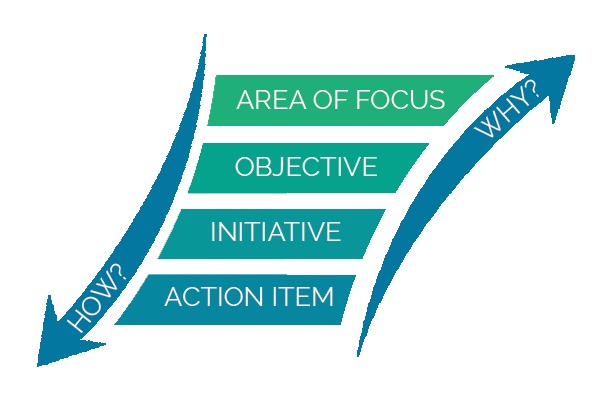For business leaders, summer marks the official kick-off of planning season. For those organizations with fiscal years that begin on July 1st, even the longer days still don’t seem to create enough hours for those last-minute approvals to finalize your various strategic and operational plans.
During brainstorming, mapping, and organization, executives will inevitably reach a roadblock in the plan creation process. You’re not alone – it’s difficult to put the final touches on such a cumbersome plan that will guarantee most of your initiatives will see the finish line next year.
Then, once you have your plan finalized (whether it’s operational, strategic, or project management), what are some cultural changes you can champion to ensure its execution?
If you’re up against the clock, here’s a simple, tested method we use at AchieveIt to quickly finalize your plan content and motivate your teams.
All Strategic Plans Should Answer “How?” and “Why?”
We always recommend taking the time to carefully optimize your plan with a room full of stakeholders. I have a lot of experience sitting in conference rooms, going over plans line by line with a table full of executives, and bringing to light many missing items that make plans effective: due dates, accountability, success metrics, plan alignment, etc. It’s better to work this way to avoid becoming a victim of the Planning Fallacy. However, if you need to have your plan prepped and ready for execution tomorrow – I recommend using the simple gut-check described below.
In its purest form, planning comes down to two main questions.
How? and Why?

Let me show you how to apply these two questions through an example:
1. Define Your Focus
Let’s say you work for a healthcare organization. You’re in the process of developing your plans.
The top-level of your plan is most likely called an area of focus, pillar, or strategic priority. (The terminology doesn’t matter; what those words represent is what’s important to the organization.)
If someone were to say, “What are you focused on this year?” you might reply with: safety, quality, patient satisfaction, and growth.
2. How: Build Out the Measurements
Now that you’ve defined your focus, it’s time to build out the details of what you’re going to do in each of those areas of focus to create the change you wish to see. This is where you ask yourself, “How?”
If your area of focus is safety, how are you going to know you’ve definitely improved in that area?
I would recommend leveraging quantitative measures whenever possible to define success. e.g. “Decrease harm events by 15%” would be a perfect way to know if you’ve improved safety.
Alternatively, you can call this level of your plan: measures, objectives, or key performance indicators.
3. How: Define Activities and Resources
Now that you’ve established success criteria in the form of objectives or KPIs, how will you ensure you reduce harm events by 15%? What activities will help you get to your 15% goal?
These actions will tier down as you fill in the specifics. You might, for instance, select an initiative that aims to start holding daily safety huddles in each service line. Since implementing lean thinking and daily huddles is a big undertaking, ask yourself how you will launch the roll-out of those huddles. Start by defining action items, like picking a safety champion in each service line. How will you choose each safety champion? (Keep building down from here.)
If you ask yourself how at every level in your hierarchy, you’ll be able to build the details of your plan in no time.
4. Why: Check Your Work
Okay, let’s recap what we defined above before applying our next step:
1) Area of Focus: Safety
2) Objective: Reduce harm events by 15%
3) Initiative: Implement daily safety huddles in each service line
4) Action Item: Pick a safety champion from each service line
Why helps you check your work. If your plan is built properly, every time you ask yourself why, the answer should be the next level up in your plan:
Why should we pick a safety champion for each service line? To help roll out the practice of daily safety huddles.
Why are we implementing daily safety huddles in each service line? In order to help decrease harm events by 15%.
Why do we want to see that reduction? We want to improve safety.
The Power of “Why” in Strategic Planning
The most powerful takeaway?
Asking why also ensures that everyone in your organization completely understands the connection between their work and the organizational strategy.
This is key.
If your entire organization is aligned, all forces will be applied in the same direction, pushing towards accomplishing the same great things you planned together.
If every employee understands the why behind every task – from filing insurance claims to building parking decks to sterilizing tools for spinal surgery – your organization can become culturally united and celebrate victories, large and small, together.
Conduct the How & Why Test Against Your Strategic Plan
Try asking how you move down your plan, and why as you move up your plan. If you have a hard time aligning a tier to the one above it, you’ve found a hole in your plan that needs patching.
Using this method, I think you’ll find will allow you to build an effective and compelling plan of any kind that is primed for execution. Now, as a business leader, read how other executives like you are helping sustain organizational change.
Ready to improve your plan execution?
Organizations of all types leverage AchieveIt to manage, execute, and connect their most important initiatives. Replace manual processes & siloed systems with interconnected plans in a single, automated platform.



